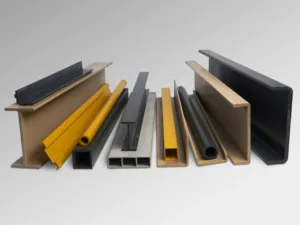Fiber Reinforced Polymer (FRP) materials have revolutionized industries with their exceptional properties and versatile applications. This composite material, consisting of fibers embedded in a polymer matrix, brings forth a blend of strength, durability, and corrosion resistance that has made it a staple in various sectors. In this article, Unicomposite composite profiles will dive deep into the world of FRP material, exploring its composition, manufacturing process, and the diverse range of domains it influences.

what is frp material
Introduction to FRP Material
FRP material, also known as Fiber Reinforced Polymer, is a composite substance composed of high-strength fibers embedded within a polymer matrix. The combination of these materials results in a product that outperforms traditional materials in various aspects.
Composition and Manufacturing Process
FRP materials are created through a meticulous process. The fibers, commonly glass, carbon, or aramid fibers, provide the strength, while the polymer matrix, often epoxy or polyester resin, holds them together. The manufacturing process involves impregnating the fibers with the polymer resin, followed by curing to create a solid, durable material.
Advantages of FRP Material
FRP material boasts a multitude of advantages, making it a sought-after choice in many applications. Some key benefits include:
1. Exceptional Strength-to-Weight Ratio
FRP materials offer a remarkable strength-to-weight ratio, allowing them to provide substantial strength without adding excessive weight. This property is crucial in applications where weight is a critical factor, such as aerospace engineering.
2. Corrosion Resistance
Unlike traditional materials like steel, FRP is highly resistant to corrosion. This resistance makes it ideal for environments exposed to moisture, chemicals, or saltwater, prolonging the material’s lifespan.
3. Design Flexibility
FRP materials can be molded into various shapes and sizes during the manufacturing process. This flexibility facilitates intricate designs and complex geometries that would be challenging to achieve with other materials.
4. Durability and Longevity
The combination of strong fibers and resilient polymer matrix grants FRP materials exceptional durability and longevity, reducing maintenance costs and increasing the lifespan of structures.
Applications Across Industries
FRP materials find applications across a wide spectrum of industries, including:
1. Construction
In construction, FRP is used for reinforcing concrete structures, providing added strength and seismic resistance. It’s also employed in architectural features due to its design versatility.
2. Automotive
FRP materials are used to manufacture lightweight yet sturdy automotive components, improving fuel efficiency and overall performance.
3. Aerospace
The aerospace industry benefits from FRP’s lightweight properties and high strength, enhancing the efficiency and safety of aircraft components.
4. Marine
FRP’s resistance to corrosion makes it an excellent choice for marine applications, including boat hulls, decks, and other components exposed to harsh marine environments.
5. Sports and Recreation
FRP materials are used in sports equipment like tennis rackets, hockey sticks, and bicycle frames, where the balance between strength and weight is crucial.
Environmental Impact and Sustainability
The environmental impact of FRP materials is a topic of interest. While the manufacturing process requires energy, the durability and longevity of FRP products can lead to reduced resource consumption in the long run. Additionally, research into eco-friendly polymer resins is ongoing to enhance the material’s sustainability.
Future Innovations in FRP Technology
As technology advances, so does the potential of FRP materials. Researchers are exploring ways to enhance its properties further, such as developing self-healing materials and incorporating nanotechnology for improved performance.
Conclusion
In the world of materials science, Fiber Reinforced Polymer (FRP) stands as a remarkable achievement. Its exceptional attributes, ranging from strength and durability to versatility and corrosion resistance, have reshaped industries. From construction to aerospace, FRP’s impact is undeniable, and its journey of innovation continues, promising exciting possibilities for the future.
FAQs
Q1: Is FRP material stronger than steel?
A1: Yes, FRP material can have a higher strength-to-weight ratio than steel, making it a preferred choice in various applications.
Q2: Can FRP be recycled?
A2: Recycling FRP materials is challenging due to the complex combination of fibers and polymers. However, research is ongoing to find sustainable solutions.
Q3: What is the lifespan of FRP products?
A3: FRP products can have a longer lifespan compared to traditional materials due to their resistance to corrosion and durable nature.
Q4: How is FRP used in the automotive industry?
A4: FRP is used to create lightweight components in vehicles, contributing to fuel efficiency and overall performance improvement.
Q5: Is FRP eco-friendly?
A5: While the manufacturing process has an environmental impact, the durability and potential for recycling make FRP a more sustainable choice in the long term.
 info@unicomposite.com
info@unicomposite.com


























